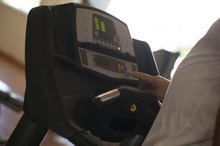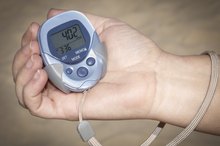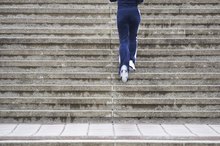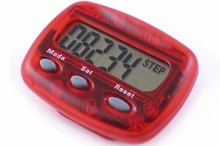How to Exercise at 80 to 90 of Maximum Heart Rate
A tough workout leaves you drained, breathless, and exhilarated by what you have accomplished. There are many benefits to this type of workout, including an afterburner effect that has you burning calories long after the workout is over. Known as excess post-exercise oxygen consumption, according to The Walking Site, it is the anaerobic zone, meaning 80 to 90 percent of your maximum heart rate that results in an improved cardiovascular system and better recovery from your workouts 1.
Pick a timing protocol for your workout. Use short but intense periods of exercise followed by shorter rest periods. According to website All About Tabata Training, 20 seconds of exercise with 10 seconds of rest for four-minutes rounds provide the most benefit 2. The rounds and set durations can be modified, but always use a two to one (or greater) ratio of exercise time to rest time.
How to Program a Treadmill
Learn More
Prepare your equipment as necessary. For example, if using a treadmill, set the incline and speed to a challenging level. Set a high resistance for pedaling if you will use an exercise bike. Select the circuit of exercises you will use for bodyweight exercises.
Calculate your target rate by using the following formula: 220 minus your age 1. Multiply that number by 0.8 and 0.9. The result is 80 to 90 percent of your target heart rate 1. Staying within this range is your goal for the workout.
NordicTrack A2050 Specs
Learn More
Warm up for your workout. Dynamic stretching, including leg swings and trunk rotations are better for warming up than static stretching, including stretch and hold-type positions, which actually makes you weaker and can lead to difficulty during your workout.
Put on the heart rate monitor, following the instructions that came with it. You should be able to see the readout at a glance between rounds to ensure your heart rate is in the prescribed range 1.
Set the interval timer for your workout using the timed periods listed in your workout plan.
Perform the workout as prescribed. Check your heart rate between each round to ensure that it is in the proper range 1. If your heart rate is too low, increase the pace 1. If your heart rate is too high, then stop and rest until the rate slows 1. This would mean that your pace was too high, so slow down your pace the next workout to ensure that your heart rate falls into the prescribed range 1.
Cool down from the workout by setting a walking pace at a low incline on the treadmill or slowly pedaling at a low resistance on the exercise bike. Walk for a few minutes if you were doing bodyweight exercises.
Tips
Start slow and work your way up through these workouts.These workouts allow you to set your own pace. You will get more of a benefit from the workout the harder you push yourself.
Your body will begin to adjust to these types of workouts, so continue to add difficulty to your workouts.
Increasing the speed on the treadmill or the resistance on the exercise bike will make it tougher. Adding difficulty to the bodyweight exercises will help as well. For example, try squat jumps instead of squats. Raise your arms during the cool down period. This will allow to you increase the amount of oxygen you take in with each breath.
Warnings
These types of workouts can be dangerous so consult with a physician before trying them. If you feel dizzy or nauseous at any time during the workout, stop immediately and rest. If the feeling persists, seek medical attention.
Be cautious when getting on and off the treadmill during the workout. This requires jumping on and off of a moving treadmill. Practice at slow speeds until you are comfortable before increasing the speeds.
Related Articles
References
- The Walking Site: Your Target Heart Rate
- Tabata Exercise: All About Tabata Training
- American Heart Association. Know your target heart. Updated June 2015.
- Edwards S. The Heart Rate Monitor Guidebook. Velo Press. 1999.
- American Heart Association. Know your target heart rates for exercise, losing weight and health. Updated June 2015.
- Harvard Medical School. Do you need to talk to a doctor before starting your exercise program?.
- Brookreson N. Using Heart Rate Monitoring for Personal Training. American College of Sports Medicine. https://certification.acsm.org/blog/2015/july/using-heart-rate-monitoring-for-personal-training.
Tips
- Start slow and work your way up through these workouts.These workouts allow you to set your own pace. You will get more of a benefit from the workout the harder you push yourself.
- Your body will begin to adjust to these types of workouts, so continue to add difficulty to your workouts.
- Increasing the speed on the treadmill or the resistance on the exercise bike will make it tougher. Adding difficulty to the bodyweight exercises will help as well. For example, try squat jumps instead of squats.
- Raise your arms during the cool down period. This will allow to you increase the amount of oxygen you take in with each breath.
Warnings
- These types of workouts can be dangerous so consult with a physician before trying them. If you feel dizzy or nauseous at any time during the workout, stop immediately and rest. If the feeling persists, seek medical attention.
- Be cautious when getting on and off the treadmill during the workout. This requires jumping on and off of a moving treadmill. Practice at slow speeds until you are comfortable before increasing the speeds.
Writer Bio
Jay Donelson began writing fitness and nutrition articles for LIVESTRONG.COM in 2011. Jay has a Bachelor of Arts in English from West Virginia University and a Master of Arts in adult education from the University of Rhode Island. He is also a National Academy of Sports Medicine (NASM) Certified Personal Trainer and a Certified Fitness Nutrition Specialist (CFNS).









